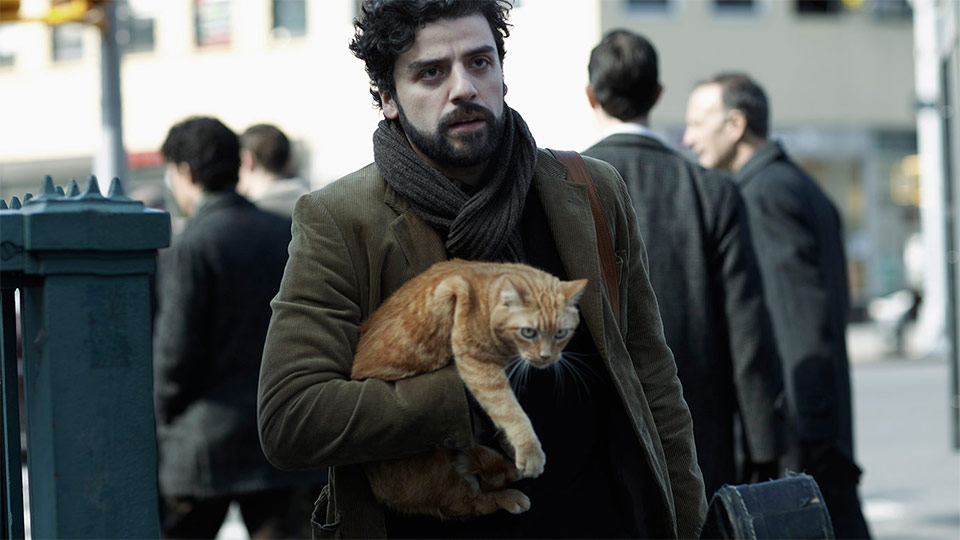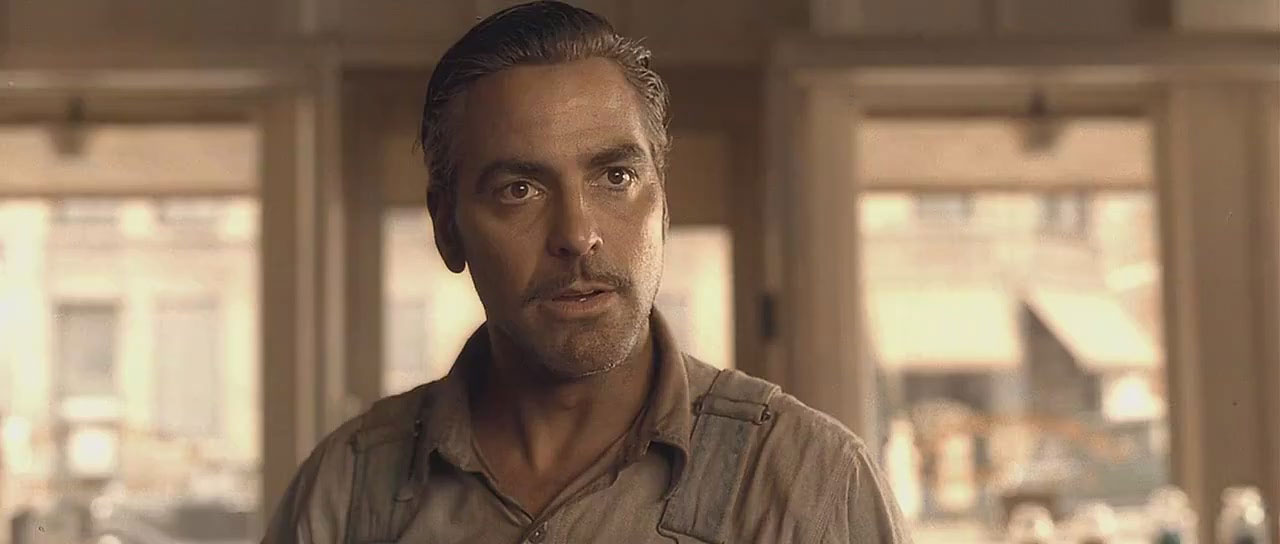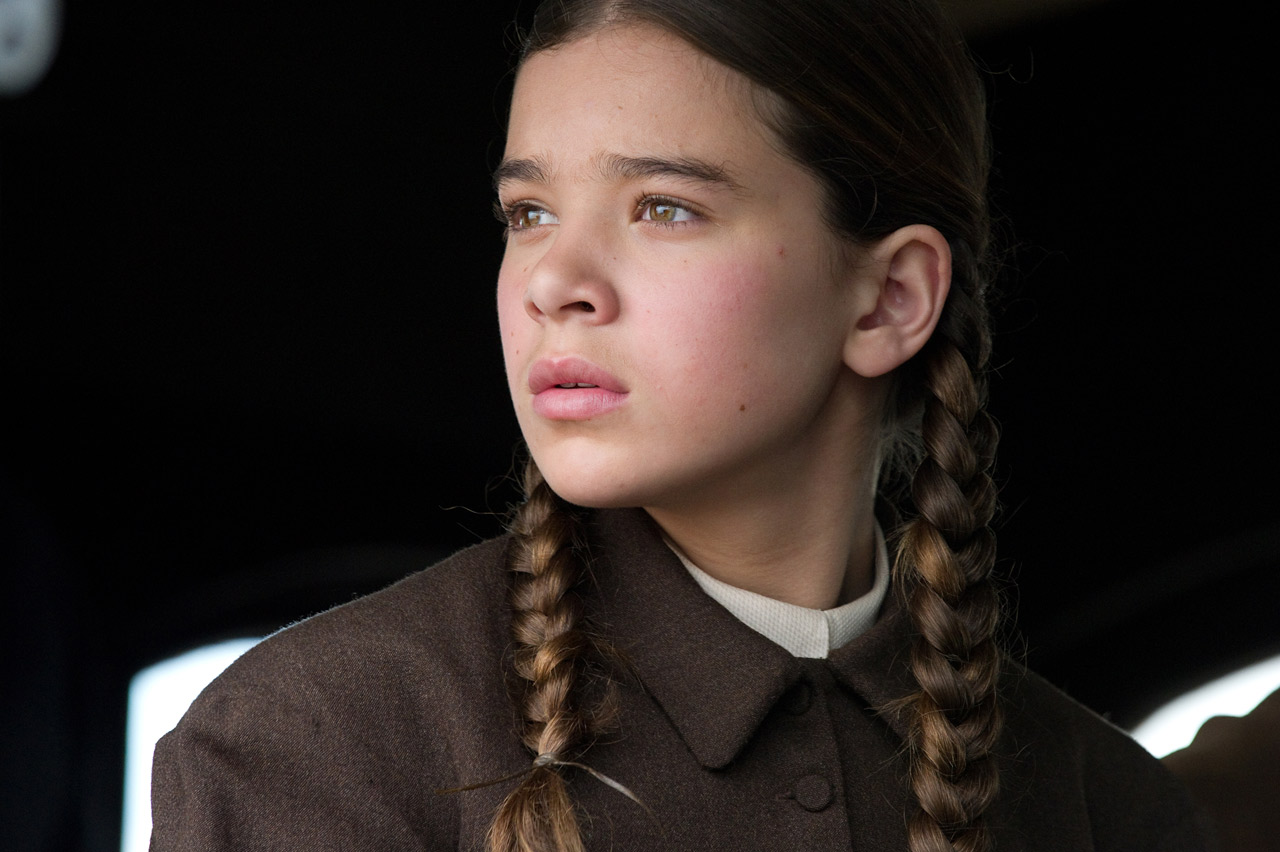Inside Llewyn Davis
My Letterboxd review of this one, written while I stood at the corner of 53rd Street and Sixth Avenue, waiting to grab some chicken and rice directly after a screening, reads like this: "The Ballad of the Unlikeable Protagonist: Coen Brothers' Greatest Hits (CBS 2013)." I couldn't figure out on short notice what else to do with Inside Llewyn Davis. It's maybe the first Coen Bros. film that seems to settle into sampler territory — it has the frustrated creative protagonist from Barton Fink, the Odyssey references and period-music revivalism of O Brother, Where Art Thou?, the John Goodman character role from, well, several of 'em. And its folk-singing wannabe title character really is a piece of work. Abrasive, overly serious, and a mite noxious in his sense of entitlement and estimation of self-worth, frustrated New York folkie Llewyn Davis is the epitome of problematic artistic temperament — a lost cause from square one.
But it sure sticks with you. That's partly because Oscar Isaac just plays Llewyn Davis really well. Llewyn is prideful, defensive, and selfish, but most of all he's weary. And Isaac sure looks bone-tired — spiritually haggard. He's tired of making the argument in favor of himself. It's his redeeming facet. He's been working on the early 1960s Greenwich Village folk circuit so long, daring to fantasize about so many more dignified outcomes of his investment in his art, that it's easy to feel for the guy. The woman he loves wants nothing to do with him. His manager is exploiting him. His sister doesn't see him as an artist. His peers in the music business are more callow and more calculated, but also more commercially successful. But still, when he cozies up to the mic with practiced between-song patter — "If it was never new and it never gets old, it's a folk song" — it feels a little rote. Rehearsed. Maybe even a tad smarmy. If there ever was a real fire animating Llewyn's music, the ember has gone cold. He's going through the motions, and it's a little bit heartbreaking. He's talented, but he's not talented enough. It's a problem that can't be fixed, and Inside Llewyn Davis is the cruel story of his realization.
The critter I mentioned above is a cat — a willful thing that jumps into the hallway just as the front door of the upscale apartment where he crashed for the night slams shut and locks, cursing our protagonist with one more damned thing to keep track of. The cat all but announces itself as a plot device — a wisp of connective tissue giving the story a hint of cohesion it would otherwise be lacking, especially when Llewyn hits the road. There's another gimmick at work, but it's a trickier one that won't reveal itself until the film's final scenes, which have the feel of a valedictory, folding in on themselves in a way that suggests a certain fatalism. The Coens' title is, I think, deliberately cute — hard to imagine anyone would want to be "Inside" the character they've created. But the film is deeply felt. Requiem for a Dream would be more like it.
Inside Llewyn Davis takes place in February 1961, a moment in time when folk music dominated hipster culture in downtown Manhattan. Llewyn Davis is one of the latter-day folk-singers hoping to reach the masses with his music, but he's getting nowhere with his performances at the Gaslight Cafe and an album, Inside Llewyn Davis, the royalites from which won't even pay for a coat. The winter is Llewyn's unsparing adversary, especially as he travels to Chicago to seek an audience with Bud Grossman, a kind of kingmaker for singer-songwriters of the era, but his worst enemy is himself. He's knocked up a woman, Jean (the fiercely angry Carey Mulligan), one of his only friends in the world, who seems to simultaneously pity and despise him, but blames him entirely for the predicament she finds herself in, and naturally expects him to pay for the procedure that will make it right. He can't help but explode in a fit of misplaced self-righteousness when one of his only friends in the world, the kind wife of a generous college professor in that aforementioned upscale apartment, urges him to play a song for her dinner guests. And he fairly seethes with resentment over the success of perceived rivals like the harmonizing, sweater-topped Irishmen who croon at the Gaslight, or his amiable buddy Jim (Justin Timberlake), hisband of Jean.
He even has the bad graces to bitch about the quality of song when he sits in on a session with Jim, who has written a novelty ditty based on the idea of President Kennedy promising to send a man to the moon, and the chosen astronaut balking at the assignment. Llewyn doesn't know Jim was the songwriter, but his more damning transgression is his failure to recognize a hit. If he opted for a cut of the royalties rather than a single lump-sum payment, well, Inside Llewyn Davis might have a much more upbeat ending. The scene depicting the recording session is a highlight not just of this film, but of the whole year in film. Music supervisor T-Bone Burnett has worked up an actual catchy ditty, and Timberlake's practiced earnestness, alongside some appropriately goofy background singing by Girls supporting player Adam Driver, sells the piece as a real radio hit from the era. (I was immediately reminded of the semi-racist 1960 semi-classic "Mr. Custer," whose golly-gee vocal stylings make Driver's grin-inducing schtick seem exactly right.) Equally important is the Coens' light touch in the editing suite. Once "Please Mr. Kennedy" ramps up, Llewyn Davis is firing on all cylinders, with every cut just emphasizing Llewyn's apprehension, Jim's enthusiasm, or the deadpan groove of the producer (Ian Jarvis, bopping around almost imperceptibly) as he watches from the control booth, before moving to the next beat.
You feel sorry for Llewyn, of course. Nobody likes to be cold, and the close-up insert of Llewyn squeezing water out of a shoe super-saturated with the icy damp will have a chilly resonance for anyone who's ever worn clothes with holes where there should be none because they lacked the cash to replace their threadbare apparel. And Davis has a really fine moment where his face just registers a kind of searing pain over some dispiriting news about an old girlfriend's whereabouts. He tamps it down, but it comes roaring over the top again in a late-film scene where he spits unforgivable sexist bile at another musician performing at the Gaslight. We understand where the invective comes from. (It's been a hard week for Llewyn Davis.) But it's ugly stuff.
Along with Burn After Reading, this is one of the only latter-day Coen films that isn't shot by Roger Deakins. Instead, Bruno Delbonnel (Amelie, Across the Universe, and Dark Shadows, though you can't blame him for those) comes on board to shoot in a sort of desaturated style that again suggests New York in its most unkind climate. The picture is striking and nearly grainless — I erroneously assumed it was shot digitally, but Delbonnel actually exposed 35mm film — in a way that evokes the correct period mood without resort to visual clichés. A long sequence in the film's midsection that has Llewyn sharing a ride on the long highway with a verbose and voluminous blues man (John Goodman) apparently inspired partly by Doc Pomus is disorienting because it heralds a sudden shift in the film's tone to mysterious-journey mode, with the whole world disappearing into darkness just outside the sedan windows. And when Llewyn finally arrives on the outskirts of Chicago, there's a bewildering shot in which the city's skyline looks like nothing so much as a cardboard cut-out, the phony city of dreams from a 1930s backstage musical.
Certain respites notwithstanding, the temperature remains cold throughout, reaching new lows whenever the impossibly slim, besweatered Jean appears on screen to heap her righteous icy reproach upon our hero. (The film's portrayal of Jean as resolutely unsupportive and unforgiving of Llewyn's transgression might border on caricature if it weren't so clear that the object of her scorn richly deserves the opprobrium.) By the time Llewyn gets a chance to perform for the magisterial industry kingpin he feels he deserves an audience with, we've already sussed out the problem. His performance is solid, even impressive, and he holds his convictions. But there's little warmth left in his music, no matter how impeccably performed. No heart. Conviction doesn't substitute for cleverness, authenticity is no match for innovation, and Davis, a perfect standard-bearer without the spark of the new, is best suited to the position he refuses to take — as a sideman, a supporting player in someone else's more charismatic story. It's the same pride that leads him to insist that his sister throw out his old rehearsal tapes lest they ruin his "mystique."
"Stop worrying if your vision is new," Stephen Sondheim wrote in Sunday in the Park with George, a great musical that wrestles with questions about creative inspiration and the worthiness of art. "Let others make that decision; they usually do." The world was already moving on by the time Llewyn Davis reached the height of his potential, when the powers that be found him wanting for vision. Meanwhile, folk music was about to be transformed by a shaggy-headed poet and practical joker whose unmistakable silhouette we glimpse in the film's closing minutes. Bob Dylan's arrival on the New York folk scene was, as far as Llewyn Davis was concerned, the sound of the A train leaving the station. And that cat? The one he takes custody of, loses, finds, then loses again? Turning the movie over in my head, letting it play through again and again, I realized that, as Llewyn's story turns recursive, with the threat that he'll make the same mistakes over and over again, the cat is not just his learning opportunity but his shot at redemption — a spirit animal that symbolizes both death and rebirth. If he learns to see himself there, the Coens suggest, it could be his salvation.



